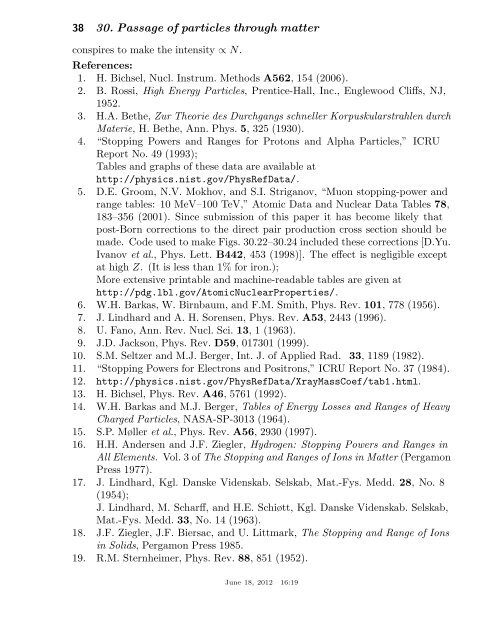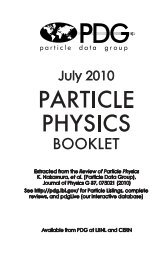30. Passage of particles through matter 1 - Particle Data Group
30. Passage of particles through matter 1 - Particle Data Group
30. Passage of particles through matter 1 - Particle Data Group
You also want an ePaper? Increase the reach of your titles
YUMPU automatically turns print PDFs into web optimized ePapers that Google loves.
38 <strong>30.</strong> <strong>Passage</strong> <strong>of</strong> <strong>particles</strong> <strong>through</strong> <strong>matter</strong><br />
conspires to make the intensity ∝ N.<br />
References:<br />
1. H. Bichsel, Nucl. Instrum. Methods A562, 154 (2006).<br />
2. B. Rossi, High Energy <strong>Particle</strong>s, Prentice-Hall, Inc., Englewood Cliffs, NJ,<br />
1952.<br />
3. H.A. Bethe, Zur Theorie des Durchgangs schneller Korpuskularstrahlen durch<br />
Materie, H. Bethe, Ann. Phys. 5, 325 (1930).<br />
4. “Stopping Powers and Ranges for Protons and Alpha <strong>Particle</strong>s,” ICRU<br />
Report No. 49 (1993);<br />
Tables and graphs <strong>of</strong> these data are available at<br />
http://physics.nist.gov/PhysRef<strong>Data</strong>/.<br />
5. D.E. Groom, N.V. Mokhov, and S.I. Striganov, “Muon stopping-power and<br />
range tables: 10 MeV–100 TeV,” Atomic <strong>Data</strong> and Nuclear <strong>Data</strong> Tables 78,<br />
183–356 (2001). Since submission <strong>of</strong> this paper it has become likely that<br />
post-Born corrections to the direct pair production cross section should be<br />
made. Code used to make Figs. <strong>30.</strong>22–<strong>30.</strong>24 included these corrections [D.Yu.<br />
Ivanov et al., Phys. Lett. B442, 453 (1998)]. The effect is negligible except<br />
at high Z. (It is less than 1% for iron.);<br />
More extensive printable and machine-readable tables are given at<br />
http://pdg.lbl.gov/AtomicNuclearProperties/.<br />
6. W.H. Barkas, W. Birnbaum, and F.M. Smith, Phys. Rev. 101, 778 (1956).<br />
7. J. Lindhard and A. H. Sorensen, Phys. Rev. A53, 2443 (1996).<br />
8. U. Fano, Ann. Rev. Nucl. Sci. 13, 1 (1963).<br />
9. J.D. Jackson, Phys. Rev. D59, 017301 (1999).<br />
10. S.M. Seltzer and M.J. Berger, Int. J. <strong>of</strong> Applied Rad. 33, 1189 (1982).<br />
11. “Stopping Powers for Electrons and Positrons,” ICRU Report No. 37 (1984).<br />
12. http://physics.nist.gov/PhysRef<strong>Data</strong>/XrayMassCoef/tab1.html.<br />
13. H. Bichsel, Phys. Rev. A46, 5761 (1992).<br />
14. W.H. Barkas and M.J. Berger, Tables <strong>of</strong> Energy Losses and Ranges <strong>of</strong> Heavy<br />
Charged <strong>Particle</strong>s, NASA-SP-3013 (1964).<br />
15. S.P. Møller et al., Phys. Rev. A56, 2930 (1997).<br />
16. H.H. Andersen and J.F. Ziegler, Hydrogen: Stopping Powers and Ranges in<br />
All Elements. Vol. 3 <strong>of</strong> The Stopping and Ranges <strong>of</strong> Ions in Matter (Pergamon<br />
Press 1977).<br />
17. J. Lindhard, Kgl. Danske Videnskab. Selskab, Mat.-Fys. Medd. 28, No. 8<br />
(1954);<br />
J. Lindhard, M. Scharff, and H.E. Schiøtt, Kgl. Danske Videnskab. Selskab,<br />
Mat.-Fys. Medd. 33, No. 14 (1963).<br />
18. J.F. Ziegler, J.F. Biersac, and U. Littmark, The Stopping and Range <strong>of</strong> Ions<br />
in Solids, Pergamon Press 1985.<br />
19. R.M. Sternheimer, Phys. Rev. 88, 851 (1952).<br />
June 18, 2012 16:19







